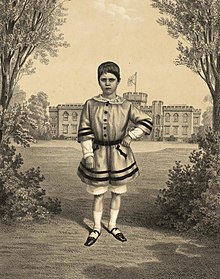John Crichton-Stuart, 3rd Marquess of Bute
Lord Colum Lady Margaret | |
|---|---|
| Parents | John, 2nd Marquess Lady Sophia Rawdon-Hastings |
John Patrick Crichton-Stuart, 3rd Marquess of Bute,
When Bute succeeded to the
Lord Bute died in 1900, at the age of 53; his heart was buried on the
Early life

The future Marquess was born at the family seat of Mount Stuart, on the Isle of Bute in Scotland, to John, 2nd Marquess of Bute, and Lady Sophia Rawdon-Hastings, daughter of The 1st Marquess of Hastings.[3] At birth, he was known by the courtesy title Earl of Dumfries.
The 2nd Marquess was an industrialist and began, at great financial risk, the development of Cardiff as a port to export the mineral wealth of the South Wales Valleys. Accumulating major debts and mortgages on his estates, the Marquess rightly foresaw the potential of Cardiff, telling his concerned solicitor in 1844, "I am willing to think well of my income in the distance." The following fifty years saw his faith vindicated, but the ensuing riches were to be enjoyed, and spent, by his son, "the richest man in the world",[4] rather than himself.

The 2nd Marquess died in 1848 and his son succeeded to the Marquessate when less than six months old. He was educated at
Interests

The Marquess's vast range of interests, which included religion, medievalism, the occult, architecture, travelling, linguistics, and philanthropy, filled his relatively short life. A prolific writer, bibliophile and traveller, as well as, somewhat reluctantly, a businessman, his energies were on a monumentally Victorian scale. "A liturgist and ecclesiologist of real distinction",[9] he published on a wide range of topics. But at a distance, just over one hundred years from his death, it is his architectural patronage as "the greatest builder of country houses in nineteenth-century Britain"[10] that creates his lasting memorial.
In 1865, the Marquess met
As a
Patronage

The Marquess's patronage was extensive, with a particular enthusiasm for buildings of religion and academia. Whilst
Between 1868 and 1886 he financed the rebuilding of St Margaret's Parish Church, Roath, Cardiff, creating a new mausoleum for the Bute family with sarcophagi in red marble.[14]
In 1866 he donated a site in Cardiff Docks for the Hamadryad Hospital Ship for sick seafarers and, on his death in 1900, bequeathed £20,000 towards the cost of a new bricks-and-mortar hospital, which became the Royal Hamadryad.[15]
The Marquess of Bute's Case
The Marquess was involved in a notable
Family life
John, 3rd Marquess of Bute, married Gwendolen Fitzalan-Howard (daughter of The 1st Baron Howard of Glossop and granddaughter of The 13th Duke of Norfolk) in 1872 and had four children:
- Lady Margaret Crichton-Stuart (24 December 1875 – 6 June 1954)
- John, 4th Marquess of Bute (20 June 1881 – 16 May 1947)
- Lord Ninian Edward Crichton-Stuart(15 May 1883 – 2 October 1915)
- Lord Colum Edmund Crichton-Stuart(3 April 1886 – 18 August 1957)
Works
- John, Marquess of Bute (1911). Brendan's Fabulous Voyage. via Project Gutenberg
- The Roman breviary. Translated by John, Marquess of Bute (New Rev ed.). Edinburgh: William Blackwood and Sons. 1908. via The Internet Archive
Death
Lord Bute died on 9 October 1900[5] after a protracted illness (Bright's disease), his first stroke having occurred in 1896,[7] and was buried in a small chapel on the Isle of Bute, his ancestral home. His heart was buried on the Mount of Olives in Jerusalem.
In his will he left £100,000 to each of his children, with the exception of his eldest son, who inherited the Bute estates including Cardiff Castle and the family seat, Mount Stuart House on the Isle of Bute, and Dumfries House in Ayrshire.[15]
Notes
- ^ The great landowners of Great Britain and Ireland
- ^ Converts to Rome by Gordon Gorman 1885
- ^ Hannah 2012, p. 3.
- ^ Crook 2013, p. 231.
- ^ a b Llewelyn Davies, Sir William (1959). "Bute, marquesses of Bute, Cardiff Castle, etc.". Dictionary of Welsh Biography. National Library of Wales. Retrieved 16 October 2020.
- Alumni Oxonienses: the Members of the University of Oxford, 1715–1886. Oxford: Parker and Co – via Wikisource.
- ^ a b c d Hannah 2012, p. ?.
- ^ Davies 1981, p. 26.
- ^ Cannadine 1992, p. 489.
- ^ Hall 2009, p. 91.
- ^ Girouard 1979, pp. 273–290.
- ^ Girouard 1979, pp. 336–345.
- ^ ""Lord" Mayor of Cardiff". The Cardiff Times. 25 October 1890. p. 6 – via Welsh Newspapers Online.
- ISBN 0 7478 0518 0
- ^ a b "Lord Bute's Will – Bequest to the Seaman's Hospital – Explanation of the Conditions". Western Mail. 19 October 1900. p. 5. Retrieved 10 December 2015 – via British Newspaper Archive.
References
- ISBN 0-330-32188-9.
- ISBN 978-0-7112-3349-2.
- Davies, John (1981). Cardiff and the Marquesses of Bute. Cardiff, UK: University of Wales Press. ISBN 978-0-7083-2463-9.
- ISBN 978-0-300-02390-9.
The Victorian Country House.
- Hall, Michael (2009). The Victorian Country House: From The Archives of Country Life. London: Aurum Press Ltd. ISBN 978-1-84513-457-0.
- Hannah, Rosemary (2012). The Grand Designer: Third Marquess of Bute. Edinburgh, UK: Birlinn. ISBN 978-1-78027-027-2.
External links
- Hansard 1803–2005: contributions in Parliament by the Marquess of Bute
- Catholic Encyclopedia article
- Works by John Crichton-Stuart, 3rd Marquess of Bute at Project Gutenberg
- Works by or about John Crichton-Stuart, 3rd Marquess of Bute at Internet Archive
- K. D. Reynolds. "Stuart, John Patrick Crichton-, third marquess of Bute (1847–1900)". doi:10.1093/ref:odnb/26722. (Subscription or UK public library membershiprequired.)
